#but its from macross plus
Explore tagged Tumblr posts
Text
Game Reactions: Maharlika RPG [Filipino Anime Mechs!]
Link: https://tagamantra.itch.io/maharlika-rpg-core-rulebook
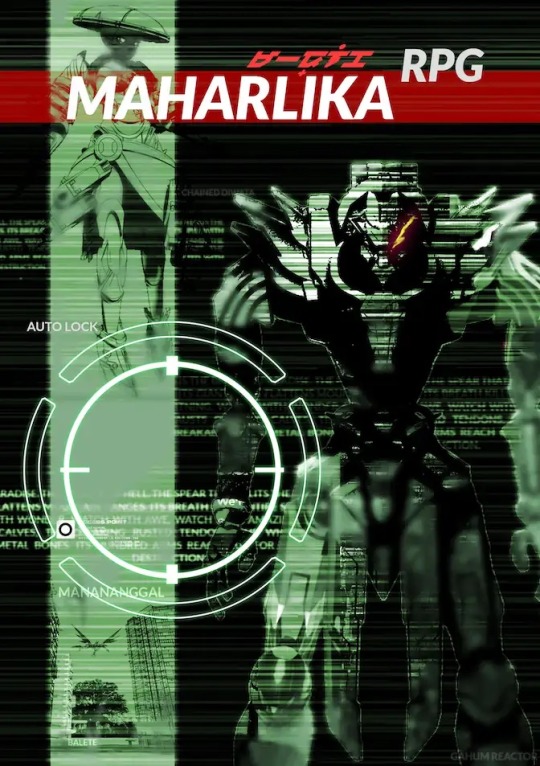
I picked Maharlika up last year at EGX (or what used to be EGX, having now been swallowed up by Comic Con) - I’d never heard of it before, but I’d gone determined to come back with a new TTRPG, and was it more exciting to buy a book that is a known quantity, or something I didn’t know existed before I saw it? Especially when it had mechs! I’ve always been a sucker for mechs. Honestly, I think my first exposure was Earthsiege 2 on the PC. Equipping different weapons on each arm, adding shoulder-mounted rockets, managing heat etc, amazing! In my late teens a friend introduced me to Gundam Wing, then Macross Plus. Somehow I fell off then, and have always wanted to really get into Gundam but never managed it. This year though, I watched Iron-Blooded Oprhans (great) and finally started to watch 0079 Gundam, listening along to the Great Gundam Project podcast. I’m halfway through Zeta now and am loving it. Needless to say, this all had me properly in the mood for reading Maharlika.
As a quick introduction, this is “a technomystic Science Fantasy mecha RPG inspired by Filipino Mythology, centered around Mekanized Weapons or Meka, and their pilots: the eponymous Maharlika.” If that sounds like a lot, it is. If that sounds awesome, yes it’s that too. It’s heavily based on Lancer, as I understand it (I own Lancer but haven’t gotten around to reading it yet), so it’s rules-light for the narrative beats and has crunchy tactical combat, which is its main focus. It’s a decent size at 220 pages, but much closer to regular book proportions than some hefty D&D tome.
Where it differs is obviously in the setting, with the designer bringing an incredible world to life by introducing the Filipino mythology. The pilots, or Maharlika, are generally teenagers (of course) who have established a connection with a divine being that becomes, in the books own phrasing, kind of like an onboard AI that allows the pilot to control these mechs that otherwise a human mind and body would be unable to. The writing really impresses on you the power of these beings, and the extent to which humans are playing with forces they don’t understand. Hey, it’s definitely anime mecha. This is just scratching the surface, as the game is far future, and very cyberpunk. Aside from the divine beings from another plane, there are aliens (including one previously invading force that humanity barely fought off), and a system of megacorps that are each as awful as the last in their own special way. These corps are the guys you’ll largely be doing missions for, and will not hesitate to come after you if you fail. All of this setting is fully realised, there are unique terms for everything, like your pilot being a Maharlika, connected to their Diwata, using their Gahum Reactor-powered mechs to do missions for the Lakanate. It definitely gave me a headache trying to keep track of everything, and honestly I’d be anxious about trying to run it, but it a cool enough world that I’d want to give it my best shot regardless.
Happily, the art is fantastic and helps to visualise the maximalist setting. A significant chunk of the book is dedicated to running through each of the five megacorps and a selection of their mech designs. Every corp has some unique approach, like the militaristic SD-SK or the theocratic KLL, and their mechs are very stylised to match. The art for each is gorgeous, I can’t show you all of my favourites or I’d be sharing half of the book, but check out the shot from the itch page below.

Really, this is what I’m here for with this book - it’s such an inspiring read, visually speaking, both in terms of the actual art, and the world described in the prose. There are some formatting issues in the book, like headings at the end of a column when the text starts in the next column, as well as a few typos. I also don’t fully love the layout and book design, with white text on a black background, using two columns on a fairly small page, and justified text which looks neat at a distance but makes the spacing really inconsistent, especially with a lot of long words that can throw off the alignment.
I already mentioned that the lore is quite daunting, and the same goes for the mechanics. As I said I’m not familiar with Lancer, and to be really clear, I am not built for tactical combat in the slightest. I wish I was, I always tried to play RTS, 4X, and tactical games of various stripes, and I’ve always been a complete plonker in every single one. I zone out in every D&D combat and really dread levelling up, because it means I need to pay attention to a bunch of stupid upgrades again. All that to say, the tactical combat here could be awesome, it could be awful, I have no idea and I’d be terrified of attempting to run it either way. There does seem to be good advice for setting up and balancing encounters, but I’d say that you and your players need to be comfortable with this kind of game, or up to the task of putting in the work to understand it sufficiently.
Regardless, whether I ever manage to run or play Maharlika or not, it’s a very cool book that I’m glad I picked up. I don’t think Filipino anime-mecha-cyberpunk-science-fantasy TTRPG is an oversaturated genre, to be honest, so this is a standout game whose world and aesthetics will stay in my head.
42 notes
·
View notes
Text


I went down another dubbing rabbit hole. I am utterly fascinated by Glitter Force right now. Glitter Force is a hacked up Americanized and censored localization of Smile Precure. Before I continue though, I need to preface with: I have not watched Glitter Force or Smile Precure. I am not an expert! This is all coming from what I've read while researching the topic and hearsay!
Just like Robotech for Macross fans, the majority of Precure fans seem to hate Glitter Force. In fact, many cheered when it was announced that it was to be removed from Netflix, sentencing it to "abandonware" oblivion. However, just like Robotech, there are a decent number of fans who were introduced to Precure (or anime in general!) through it. Similar to Robotech, it's also arguably an interesting historical artifact and so on some level worth preserving.
So despite all that, there is a bit of nostalgia for it even if the Precure fandom generally regarded it as terrible, creating legal issues, and totally botching the franchise's introduction to the west.

What's most strange to me about this whole story though is that an anime getting this kind of treatment would be normal 20+ years ago (i.e. the 4kids era), but this is so recent. This was only 2015, but they went the whole 9 yards with "4kids names", changing many scenes around through edits, cutting many episodes (48 -> 40 episodes), and a totally new soundtrack. I know less about the Doki Doki sequel, but apparently that one got even worse treatment (49 -> 30 episodes!) from Saban, who were obligated to make the series due to a deal with Toei.
Glitter Force wasn't the first Precure dub though. Ocean dubbed the original series, Futari wa Precure, for Canadian YTV. I actually have seen a couple episodes of that one, and it's honestly pretty good? I mean, it's still very localized with the changing of names (Nagisa -> Natalie) and food (e.g. Mepple wanting "chicken noodle soup"), plus other random lines occasionally get a different meaning but it's nothing like, too crazy, and as far as I know nothing is censored/cut.

I really like Nagisa's VA in the dub. She does such a good job, and the way she bickers with Mepple is fantastic. From what I've heard (shout out to Plum🌸Rose!) the OG Precure dub is considered a bit cheesy, but it's really not that bad, especially considering what came later.
From what I can tell, Toei and friends have no interest in further dubbing Precure. It's a pretty niche series in terms of the west, and I'm sure they're doing just fine with their many other massive properties to not feel like they need to make any more inroads.
If this post somehow finds its way to people who have watched Glitter Force or the OG dub, I'm curious to hear your thoughts!
#i dont generally prefer dubs but i still find them so interesting#precure#smile precure#glitter force#futari wa precure
10 notes
·
View notes
Text
Patlabor is On Lock
12 Days of Aniblogging 2023, Day 3
While Gundam is the most recognizable mecha anime I got into this year, most of my time was really spent working my way through the Patlabor franchise, and it’s quickly become one of my favorites. I’ve always loved the quiet moments in mecha shows, which makes sense considering I started with Macross and live for the bridge bunny gossip and off-duty downtown hangouts. Patlabor is built with this downtime at its core, operating with more of a slice of life mentality than anything else.
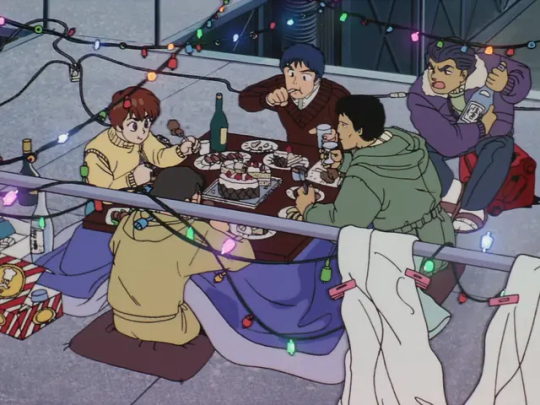
A lovable cast is crucial for making this work. Thankfully, Noa Izumi is a wonderful and unique protagonist, a scrappy soft butch who’s in it for the eroticism of the machine. The first Patlabor opening is a love letter from Noa to her mecha, and I get it! The AV-98 Ingram is an iconic design, with its asymmetric bunny ear antennae and shoulder lights and comically oversized revolver that requires the right hand to pop out in order to draw, exposing the arm wiring in the process. This is a show clearly written by first-generation mecha otaku, and plenty of time is dedicated to showing how the Labors have to be transported and recharged, how the movement software depends on reinforcement learning, showing off corporate model revisions, and of course repairs in the hangar.

Going back to the human characters, Noa’s work partner Asuma is clearly the more passive one within their dynamic, and it’s sweet to see that played out sincerely. And then there’s Kanuka Clancy, the stern weirdo badass from New York who’s constantly swearing and dropping one-liners in English. She’s the obvious breakthrough character of the show, and also the perfect opposites-attract pairing for Noa if you’re the kind of person whose yuri meter went off the charts during their drinking contest episode. Most of Patlabor’s cast seem fairly one-note at first, and one of the great tricks of the show is giving them just a little bit more depth than you would expect. Pretty much everyone, even the most jokey characters, eventually get a standalone episode or two that further sketches them out and offers real interiority. Captain Goto is another fan-favorite, and it’s definitely his mixture of laziness and wicked perceptiveness that does it, plus his main character billing in the movies.

SV2 may be a law enforcement unit, but this really isn’t a police procedural at the end of the day. These guys are the bum department out in the sticks who everyone hates, and the upside of that is that SV2 gets stuck with the oddest of jobs instead of cop work. Sometimes that’s dealing with a runaway military prototype, other times it’s arguing with the insurance company. The best kind of episodes are the ones that take almost entirely on base as everyone tries to solve a problem of their own making, like an Ingram falling into the sea or the mechanics getting into a fight with the only restaurant that delivers to them.
A main plot does eventually emerge, with a shadowy company developing a mysterious jet-black Labor piloted by a child who is the girlish boy to Noa Izumi’s boyish girl. The Griffon is sleek and curvy and has superiority in the water and air – it’s a machine designed to defeat Ingrams, and I wouldn’t be surprised if Yoji Shinkawa looked here when designing Metal Gear RAY. Automation is a fundamental ideological enemy of mecha – faceless mass production and artificial intelligence mean an end to the era of personal combat. Even Patlabor, a warless series, dips its toes into this idea in the later episodes, with Noa and the mechanics alike worrying that the neural networks in their new Labor models will make them redundant.
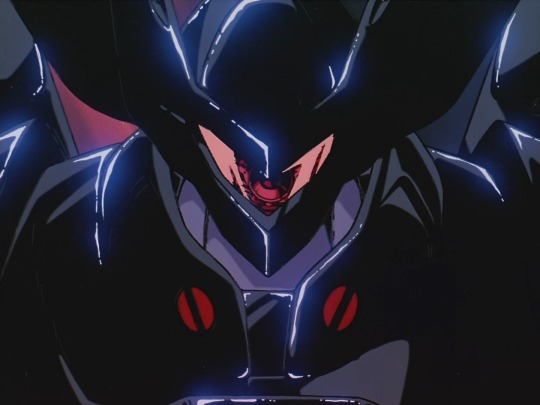
Overall, this show is hilarious and sweet and clearly loved by an older generation of otaku. So why didn’t I hear about it earlier? Partly it’s on me for not hanging out with the right mecha fans online for a while. But if I had to guess, it’s also because Patlabor is one of those works that’s straightforwardly, unobjectionably good in a way where it already says everything there is to be said about it. You can have near-infinite arguments about Zeon ideology or mobile suit powerscaling online, but there’s only so many times you can say “yeah, Noa Izumi, love that girl” precisely because everyone agrees. It can also be hard to pitch things by their vibes in a genre known for adrenaline and intrigue. Patlabor’s vibes, for the record, are immaculate.
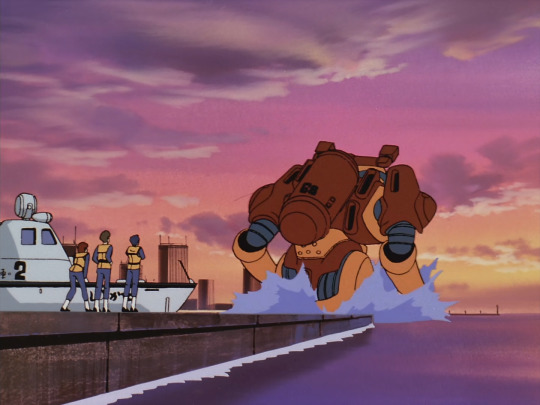
I'm probably gonna be chasing the high of cel-era sunsets forever
Mecha’s also a bit looked down upon from the outside. Anything that makes it into the larger conversation has to be understood as “elevated” or a “genre deconstruction”, even if the very first Mobile Suit Gundam is already about Amuro’s trauma and PTSD from being made into a child soldier. This elevation is actually happening to the second Patlabor movie as we speak - it’s becoming increasingly discussed as a major component of Mamoru Oshii’s filmography, divorced from its source series and instead compared to his subsequent Ghost in the Shell movie. Funnily enough, Oshii’s contributions to the Patlabor TV show are actually the more lighthearted gag episodes.
A lot of recent Patlabor retrospectives have drawn attention to the artist’s collective Headgear, established and owned by the series creators so they would be able to retain the rights for the franchise. This structure is fairly unique for the anime industry and probably only makes sense for established creatives, but it does seem to have worked out great for them, providing financial stability and strong creative control over the franchise. This allowed Patlabor to thrive in the relative wasteland of late 80s TV anime, a time when even Gundam had fled to the OVA market.
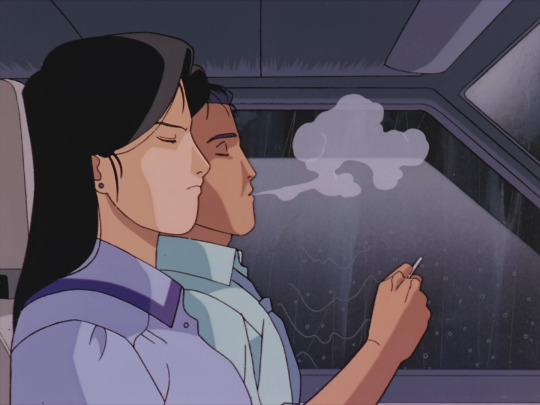
That being said, it does take Patlabor switching back to OVAs to truly spread its wings. The New Files are a conclusion and continuation of the TV series that are willing to move at their own pace, resulting in some dramatic and surprisingly thoughtful stories. It’s genuinely touching to watch Goto and Nagumo try and fail to communicate their feelings for one another in a very restrained episode as thick with long-stewing emotions as it is empty space. Of course, the very next episode has half the cast get stuck in the sewer labyrinth underneath their base and there’s a bunch of Wizardry references. Oh, Oshii.
The Patlabor movies fully lean into this melancholy and uncertainty, and it’s a welcome evolution for the series. The first movie still ends with an all-out action set piece in a half-built mecha factory that stands in for the Tower of Babel, but the second one stays serious the whole time through, going as far as pivoting to a more realistic artsyle. It’s a challenging film. The politics are all-encompassing but fairly straightforward, as Oshii effectively infodumps a presentation on the postwar history of the JSDF throughout. Instead, what the makes the movie so difficult is its willingness to face the end of an era – the Cold War is over, the bubble economy has popped, and the former members of SV2 have all gone their separate ways. The conditions that have created Patlabor, both internal and external to the show, have dissipated. And the movie makes it clear by having the military stage a raid on SV2’s headquarters, tearing their Labors to shreds with gunfire in a beautifully animated act of desecration.
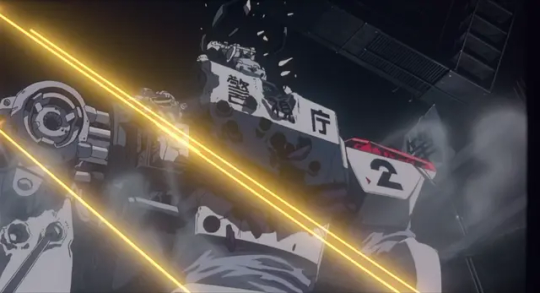
After watching her be a lovable mecha dweeb for 50 episodes, it hurts a bit to hear Noa Izumi say that she doesn’t want to be that girl obsessed with robots for the rest of her life! These characters are growing in such a way that will remove them from the focus of the narrative, and it’s a movie about letting go just as much as it is about looking towards an uncertain personal and national future. I love Miyazaki’s Porco Rosso, but the fact that Oshii put this out just one year later paints a delicious contrast between the two directors with regards to escapism versus reality with regards to militarism. There's some great interviews from the era where they're just taking potshots at each other about all this.
21 notes
·
View notes
Text

I finished Macross 7 last night... What a ride. Absolutely fantastic show.
It's clearly not Gundam. The whole thing has a much lighter tone to it. Even in the direst of straits the main characters have serious plot armor going on. There's a lightness to the tone that somewhat negates whatever stakes are happening.
But that's OK. Not everything needs to be grimdark and serious. And I really appreciated the lighter tone.
It's fun to see Macross 7 really lean into the whole "power of music" angle. Right from the start our main character is just constantly singing. That's his whole shtick. Just always, always singing. Singing defeats enemies and heals the wounded. Singing is straight-up magic.
We've got a fantastic supporting cast. So much so that I'd almost say that Mylene and Gamelin feel like co-protagonists alongside Basara. They all get ample screen-time and plenty of character development.
Speaking of Mylene though... There's a couple aspects where the show hasn't aged great - and she's one of them. The character is canonically 14 (and a very young/innocent 14 at that) and gets kind of weirdly sexualized. I mean - just look at her outfit. Several men romantically pursue her. There's several scenes where she's shown to be naive about what man and women do in private. And then about halfway through the series the end-credits change to something very uncomfortably sexualizing Mylene. I guess maybe it's a product of its times? Or its culture? But I didn't love that aspect of it.
There's some really neat mecha designs. I love the weirdly-organic look of the ships in the Macross 7 fleet. And just the incredible scale of it all... Whole cities and forests built inside these massive ships. And, of course, there's all the transforming mecha. All the valkyries featuring several neat designs. We see some VF-17 and VF-22 fighters that remind me of the YF-19 and YF-21 fighters that we see in Macross Plus... But we also briefly see Miria in her VF-1J, which is fun. And, of course, the giant battleship can also transform into a humanoid mode to fire its giant cannon.
Throughout the whole show we get some fantastic music by Fire Bomber. It felt like we really got the same few songs on repeat for a while... But around the halfway point we start getting a lot more variety. And some of these songs are seriously catchy. A few of them have definitely made it into my Spotify rotation.
Really a genuinely fun show.
I didn't love how abruptly it all ended... We get the climactic battle with the big-bad, they're defeated, and then the credits roll. There isn't really a lot of resolution or anything. But I guess there's some supplementary material to watch - so maybe that will give me the closure I'm looking for.
3 notes
·
View notes
Text

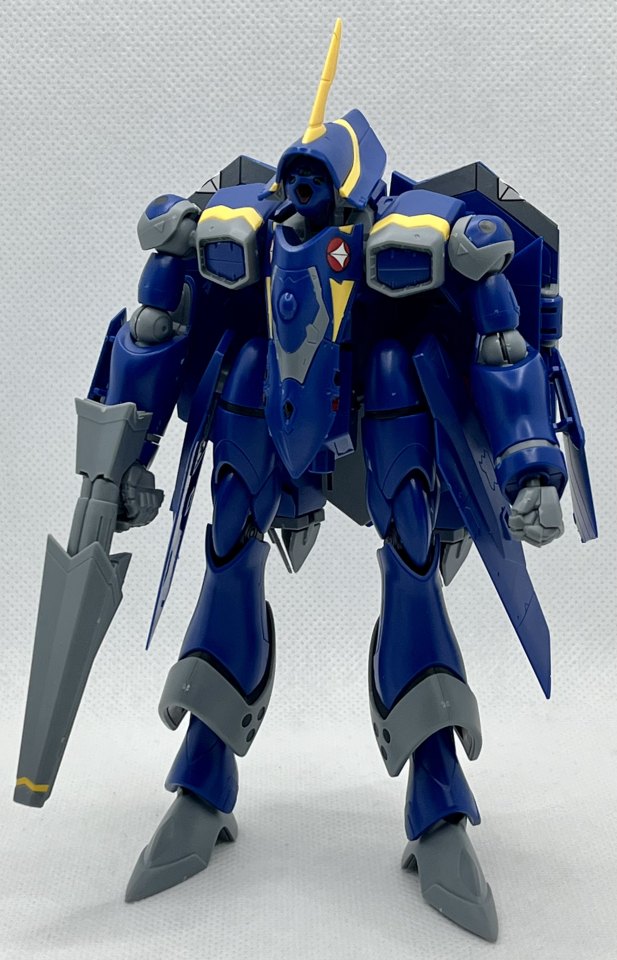

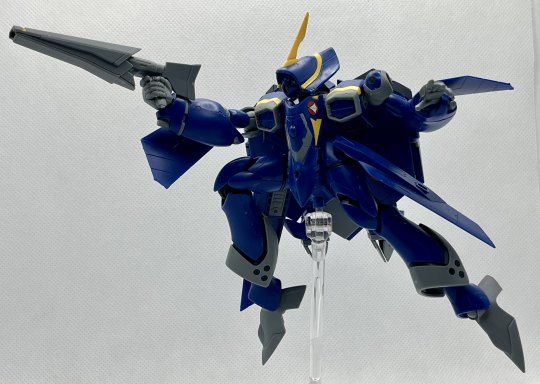
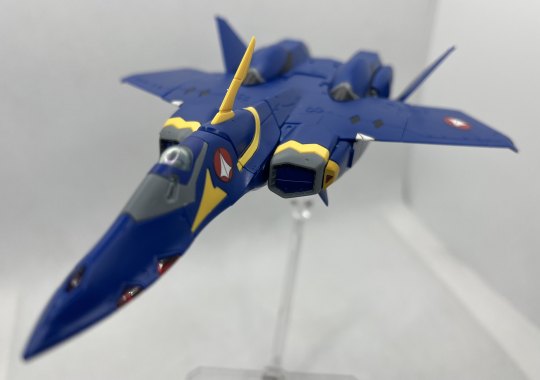
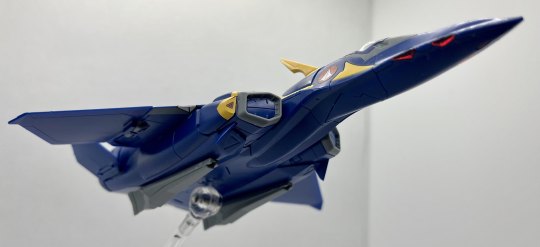

ZENTRADI GERWALK MODE! ZENTRADI GERWALK MODE!
So this was my promise to myself... I would get the partner Macross Plus kit, the YF-21 here, to go with the YF-19 I already had, and I am NOT getting other Macross kits... (unlesstheyfinallydothefirstone) Just so I don't fall down yet another rabbit hole of kits.
Guld Goa Bowman's take on the next potential Advanced Variable Fighter is... BLUE! It's also different looking, more alien, as in the lore its developed from Zentradi tech, the Zentradi being the "evil" alien faction, of which Guld is half of (and half human). Hence the unit's less earth-jet-but-a-robot robot mode.
The kit is again very good, though due to its different physical shape, it feels a little less poseable then the YF-19 was, and there's a weird inconsistency in the joints, some are very tight and others are almost loose, which made posing the thang ding for the pictures a little frustrating at times.
The parts forming decision Bandai made was the right choice all day every day. These kits look just fucking correct in all three modes, and constitute some of the only kits where I kind of want to display them in "vehicle" mode, because the jets look so good, which is something I don't normally do. Also gerwalk mode is always a treat, and the kit's balance is so good it can pose under its own power quite well even in that silly silly mode.
5 notes
·
View notes
Note
Top 5 non-big three mecha (Gundam, Getter, Mazinger)
oh shit I forgot to answer this in a timely manner! Assuming you mean shows/games as a whole, not individual mechs? If thats not what you meant just tell me and I'll try and make a list of those as well. Anyways:
5) Martian Successor Nadesico: one of the first mecha I ever watched, and something I'll always respect for its ability to run both comedic and dramatic stories so intertwined without much unintended whiplash for the viewer. I ended up never finishing it due to IRL circumstances
4) Armored Core: While the settings are universally pretty dark by my standards, FromSoft's usual storytelling leaves things vague enough for me to tolerate it. Gen 2 AC greatly influenced how I feel a mech "should" move in a 3d space when I imagine one.
3) Patlabor: Like Nadesico, is a fascinating premise able to run both comedic and dramatic storylines, though Patlabor keeps them largely separated. A lot of the designs have that elusive "just unrealistic enough to be fun" quality to them that makes me find Real Robots so interesting. The soundtrack has quite a few hits as well. Didn't finish the TV series due to streaming services changing, but love the OVA and first 2 movies.
2) Macross Plus: A part of me wants to put the whole franchise here, but considering how variable the musical style, animation quality, and overall tone can get between different entries, I chose the one I'm most familiar with. Its mysteriously nostalgic to me, something about the music, something about that late 90's early 2000s era its from, I'm not fully sure.
1) Super Robot Wars Original Generations (Games, Not Shows): It almost feels like cheating, putting this here. SRW OG has a little of everything the mecha genre has to offer while remaining both legally and tonally distinct from all of it. But an aspect I love it for that I rarely hear talked about is how well it Gradually Escalates from a reasonably grounded (for a sci-fi) setting to the Rule Of Cool Shenanigans its more well known for without the player really feeling a big disconnect until more than a few games into the saga. And for something that is still technically a crossover, that is no small feat. Also the soundtrack is consistently incredible, especially comparing the GBA versions to other games on the system.
(Honorable mentions to the Front Mission series and Dai Guard, FM doesnt make the list because every game I've played has some irksome mechanic that annoys me, Dai Guard doesn't make the list because I've only watched like 3 episodes so far)
#someone bug me to watch Dai Guard#or the Blu Rays I got at a con a while back#or like#finish any of the stuff I've started and fallen off of
3 notes
·
View notes
Text
AnimEigo to Launch Kickstarter Campaign for Macross II Anime Release
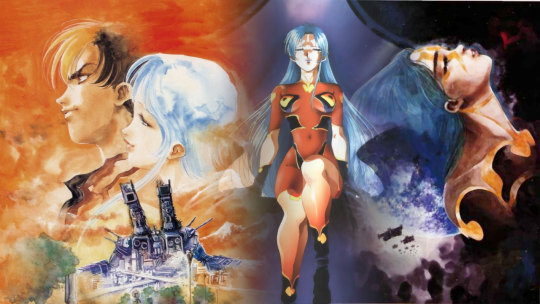
AnimEigo's Robert Woodhead announced at the Animazement event last week that AnimEigo will launch a Kickstarter campaign for the release of the Super Dimensional Fortress Macross II original video anime film this summer. The company will reveal more details at its panel at the Otakon event, which runs from July 28-30. #Macross2 Kickstarter is coming later this summer. Details at @Otakon panel. We announced this at @animazement but somehow I "spaced" on tweeting about it. If you have interesting ideas for stretch goals, tweet away! — Robert Woodhead (@AnimEigo) June 5, 2023 Biggest announced in July 2022 that AnimEigo would be releasing the anime on Blu-ray discs. At the time, Woodhead revealed on Twitter that his release of Macross II would be a high-definition transfer and not a resolution bump. The six-episode anime premiered in 1992. The story is set eight decades after Space War I and follows a civilian news reporter who meets a mysterious singer from a previously unknown alien race. Studio Nue began the Macross franchise in 1982 with The Super Dimension Fortress Macross, a television anime series featuring the themes of a love triangle, music, and transforming fighter jets. Studio Nue worked with advertising agency Bigwest and anime studio Tatsunoko Production as production partners. The franchise spawned three other television series (Macross 7, Macross Frontier, and Macross Delta), several theatrical films (beginning with The Super Dimension Fortress Macross: Do You Remember Love?), and several video series (including Macross II, Macross Plus, Macross Dynamite 7 and Macross Zero). Macross Delta aired from April to September 2016, after a trailer for the first episode in 2015. The latest animated work in the Macross franchise, the feature film Gekijōban Macross Delta: Zettai LIVE!!!!!!, opened in Japan in October 2021 along with the short film “Gekijō Tanpen Macross Frontier Toki no Meikyū” (Macross Frontier Film Short: Labyrinth of Time). Sunrise is releasing a new Macross animation project. via Anime Networks Read the full article
2 notes
·
View notes
Text
REVIEW | "MACROSS -Shooting Insight-" | B3crew.com

Hard to believe that it’s taken forever to get the MACROSS franchise over to the West, but it’s finally happened. After years dealing with Harmony Gold over its Robotech licensing fiasco, anime fans can now watch MACROSS in all of its glory. How appropriate then that a brand-new MACROSS game just so happens to arrive to celebrate the occasion. Thus, the time has come to bring all the best pilots and songstresses together in a massive crossover, in the form of MACROSS -Shooting Insight-.
Combining the worlds of MACROSS Zero, PLUS, MACROSS7, Frontier, and Delta, MACROSS -Shooting Insight- has you teaming with the best to protect the galaxy. By some strange time-warp thingy, all of the classic heroes from the series are getting together to take down a common enemy. And there’s no better way to do that than with your giant robot-transforming jet craft and an idol singer to watch your six. Of course, diving straight into battle isn’t the best strategy, but sometimes winging it is better than not fighting at all!
Click here to read the rest of the review!
#Anime#BIG WEST#Bushiroad#King Baby Duck#Macross#Nintendo Switch#PS4#PS5#reviews#Video Games#boston bastard brigade#black compat#review#��クロス#macross frontier#macross 7#macross plus#macross delta#macross zero
0 notes
Text
Macross Frontier Review
This was so fucking peak. So far this is the only Macross thing I've seen that actually has a good love triangle. To be fair to Macross 7 they basically didn't even try Basara never cared like that and Gamlin is a loser but in Macross 1 and 2 are just really mid because of good ol misogyny so you probably aren't really going to be rooting for anything etiher way because they're all losing, and then in Macross Plus Guld is a creep. That being said it's not like having a non interesting love triangle made the other series worse but having a good love triangle really makes Frontier hit so good. The romance is always an important plot element in all the series but this show does the intersection of romance and music really well, yes all the shows are like a montage of love songs but this one just hits okay. Now granted some of the side character romances are stupid, actually like all of them except for Ozma and Cathy, but that's okay. I appreciate this show only being 25 episodes. Like I said in my Macross 7 review, I don't have a problem with shows being 50something episodes, but I think you mechafans don't seem to understand that 50ish episodes is not the standard show length that should be aimed for. Could the writers have thought of things to do and ways to make this 50 episodes? Probably. But if you're going to add episodes just for the sake of something being longer and having more of it I think that is a mistake. A lot of times in these shows, espicallys one that are often driven by the relationships characters share with each other, you end up having moments basically repeated because you can't change the core idea of their relationship too much from what you want it to be but also you need things to change at least a little bit for things to stay interesting. Let's use Rain and Domon from G Gundam as an example. Their relationship follows a very clear line where the feelings that share for each other essentially exist from the beginning but they have to go through some things to both realize this and vocalize them. And it's great it makes for a really engaging and satisfying storyline. However, it is hurt a bit by the fact that the show is like 48 episodes so Domon has to learn the "his feelings of love he shares with Rain are his strongest source of power" like 3 different times, and sure each time he understands what's going on a little bit more, but generally he spends the whole show getting more emotionally intelligent, until all of a sudden that thing where Allenby gets kidnapped makes him immediately turn back into a gremlin and be basically tells Rain to go die in a hole and he haters and she's a big fat meanie poopoo head and it's like so obnoxiously over the top and because the show is so long it kind of feels like Domon really should know better than to not overreact that seriously. It's fine that he got mad it's understandable and it kind of had to happen for the story to do what it wanted to but because it's so long but with that core storyline being relatively short the final inciting incident of Domon making Rain all emo happens way too late resulting in a moment where Domon has to act even worse than a similar episode earlier in the show. Like he wasn't even that much of a dickhead in the episode with Rain's ex yuou know what I mean.
Anyways to actually talk about the show I love it. The core characters of Alto, Ranka and Sharon are just so good. Their dynamic together is just great. And you know the story kind of gets a little Metal Gear Solid in the second half and its like pretty crazy but it was so fun. Like I said I don't love some of the side characters, most of the SMS crew is good, but Luca is just kind of there and he kind of turns into a creep because at least from what I remember he never confessed or started going out with the purple girl but he still acted like they were together in the hospital scenes while she was unconcious which is like really weird man. And also I don't like Michael but honestly he never stood a chance with me you can't be the oh I'm like a playboy because I'm scared of commitment or whatever and also share a voice actor with Shinji Fate/Stay Night it just can't happen man. The music in this one is great, Ranka and Sharon have some amazing songs. I like all of Ranka's songs pretty much about the same, I love her cover of Do You Remember Love, and Sharon's Northern Cross is an all time banger. I highly recommended this to anyone interested in an Idol-Mecha-Romance Drama show. I encourage you to check out all of Macross but honestly I don't think it really matters that much where you start, sure they reference stuff that has happened in older shit but most of the time its just "I like Minmay Songs" "I like Fire Bomber" " I want to fuck a Zentradi baddy while she's not a Micron"
0 notes
Text
🎵 4Aesthetics
I don't believe they did copy his older works given how much of a departure most of the designs are and how much osmosis has happened since Kawamori's last contribution to Armored Core prior to 6 was Armored Core For Answer and only the NEXT, White Glint in 2008.
AC6 went in to development in 2018, which puts a full decade between Kawamori's prior work and the nature of mechanical design is like that of horizontal gene transfer: there's an enormous amount of contact inheritance, so much so that you can't really use terms like copy and instead iterate or explore is better -- which 100% happened given the length of the timegap.
Mecha evolution is parallel, as many have said before and Argonbolt recently reiterated -- though from a presentation standpoint the taxonomic format of the video feels shitposty, I think taxonomic-adjacent descriptors are a really good way to think about mechanical design, and design as a whole.
I haven't yet gotten around to a translated read of ARMORED CORE VI FIRES OF RUBICON OFFICIAL ART WORKS as I'm busy with other projects right, and I'm a lot less enthusiastic about 6th gen than 4th gen so its kind of on the backburner.
tl;dr of why I'm less enthused: I very much agree with the Steam page that AC6 is based on the concept of Armored Core, but I wouldn't say that it is Armored Core, truly since it lacks the fundamental combat calculus defined by rates which is why AC6 is so statistically biased over being mechanically balanced. This is why the combat doesn't resolve in a satisfying way, and why the meta keeps dancing around its fundamental problems. I noticed this before the game was released based on the motion footage we got that was leaked. Following the game, my suspicion was confirmed by Inveigh and SilverGlint who felt the same way, who I consider far more hardcore players of the game than me, and I got a few apologies from people who thought I was exaggerating the design issues. I'm still very sore about AC6, both its gameplay and its story. <grievences>
Moving along:
To my understanding, Kazutaka Miyatake, Takayuki Yanase, and Ikuto Yamashita were staff designing for Armored Core 6?
Kawamori only designed IBC03/HAL826 and IB07/SOL644 afaik.
Like he gets a lot of credit, but the idea that he does "all of the design" for Armored Core is a massive misconception.
I don't know if Makoto Kobayashi or Wataru Inata, Masahiro Miki, Akihiro Goto, Kaichi Satou or Tetsuya Taniyama have returned.
I don't understand the capacity Kawamori functions under when he staffs at FROM, but if I had to make an educated guess I'd say he either briefs other designers, or serves as a means of keeping other designs cohesive in design reviews. There isn't a lot of discussion about this.
Like Okawara, he's a designer who needs very strong direction to produce good outcomes, and I get this might be heracy but his newer work while more mechanically cohesive in terms of the ability to execute on it as a physical product like a model toy is far less stylistically ambitious with its forms.
It has a far more passive appearance which in 2024's design climate (especially that of twitter or pixiv) feels very strange in a post-Syd Mead and post-Yuzo Kojima era.
This is characterized by narrower hips and a greater emphasis on chasing a more humanoid form which ironically is less characterized, less recognizable and less iconic.
I consider this kind of strange, given that Kawamori's original trick was that audiences were really really forgiving of what a robot would look like despite being somewhat strict about vehicles, and he used this to his advantage throughout many of his transforming designs.
It feels like the problems of the mechaical designs and how hard they are to realize into functioning models in Macross Plus kinda... Haunt him? Like he girlbossed too close to the sun?
My personal theory is there's a habit of mechanical designers who get typecast or trapped into redesigning the same problem for a really long time: Just like neural networks can hallucinate or hypernormalize values beyond norms to chase a utility function the same is often true of design.
I think this is what Takeshi Murakami was trying to say in his sculpture, Second Mission: Project Ko^2, which is an anime style naked girl of the era and style of Studio Nue (when Kawamori afaik got his start) transforming into a fighter-plane in an act of fascinating if grotesque body horror.
aside: I wonder how Kawamori feels about Second Mission Project Ko^2 almost daily, and if I go to Osaka Expo 2025 (which two people want to take me to) I want to ask him since he has a booth but I feel it would be really impolite???
This is how you get really strange gangly forms, or structures which don't make a ton of sense, and is honestly the work image collaging AI systems were most interesting doing.
Human designers replicate this too:
You see it with the recent BMW car designs with their giant snouts, and you also see it in Apple's fetishistic obsession with less buttons reducing to one button with the iPod nano 3rd gen which was considered unusable since users had to memorize tap sequences to use it.
Its like a kind of Fisherian Runaway but for design
I think too, we also see this in some of Mamoru Nagano's work on GothicMade, where his reinterpretation of Mortarhedds has become hypernormalized.
I'd really need to think more on this.
I don't know why this giant discussion fell out of me, and I'm not even sure how "factual" a lot of it is.
I feel a lot of what I'm saying is probably rude or perhaps even parasocial on some level, and the thought of actually testing any of this or publishing properly would insult an entire industry of wonderful people I hold nothing but the deepest respect and admiration for.
That said, I still feel compelled to write.
Its very vibes based and while I'm providing evidence, I'm probably either making a massive mistake and confabulating information/hallucinating linkages as a mentally compromised individual with autism who thinks far too hard about fictional robots and the schools of design that link them together or I'm making an insight that people will talk about long after I'm dead if my blog survives.
Then again, maybe the fact I'm even contemplating that I might be wrong might mean I'm actually covering my bases and I might actually be right? That's... The feeling I have? I wish I were brave enough to make video essays.
The thought that someone might actually read any of what I write, and even enjoy it is one of the seven thoughts that helps me keep going through my depression.
Take care.
Remember, the ask button exists.



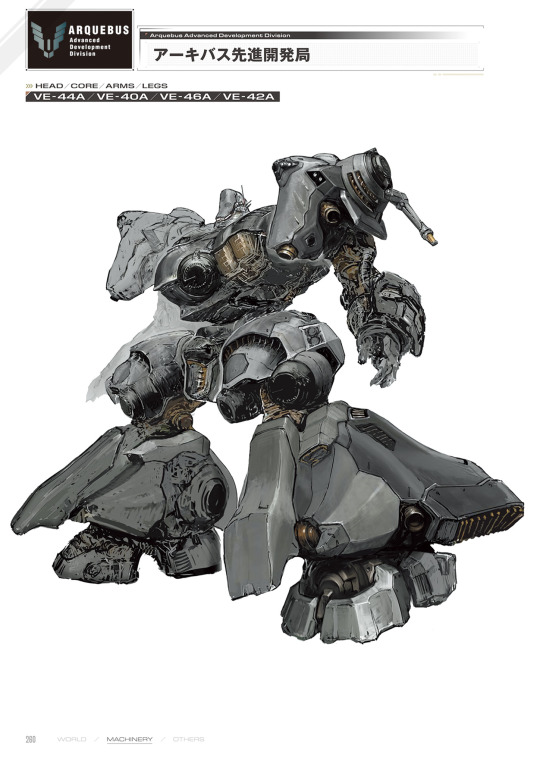

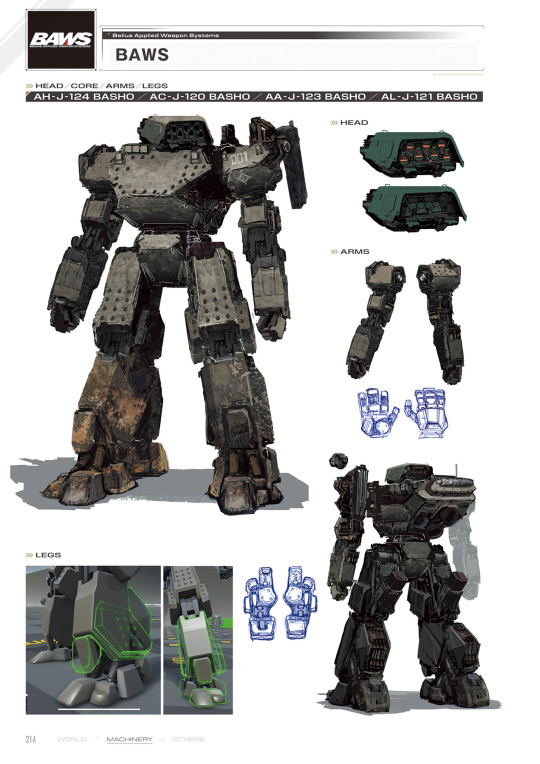
Armored Core VI Fires of Rubicon Official Art Works
#mecha#mechanical design#mechs#mech#giant robot#armored core#shoji kawamori#Takeshi Murakami#Macross#industral design#art
928 notes
·
View notes
Text
YOURE FUCKING WITH ME THERE WAS A “WANNA BE AN ANGEL” SHARON EVENT IN THE MACROSS DECULTURE GAME SUPER RECENTLY. THEY REALLY SAW MY ASS LIKE “WHOS THIS BITCH WHO BEEN LISTENING TO THIS SONG ALL YEAR WOW! LETS GIVE EM SOMETHIN”
#sheryl looks rlly cute in the angel costume it really is funny#how it decontextualizes the song from its kind of really ominous intent in macross plus#it makes sharon look like a saint for idols- hold on . she is
3 notes
·
View notes
Text
Starting a series on Macross Plus. This article is a spoiler-free intro to Macross Plus.
Macross Plus was the unofficial predecessor to Cowboy Bebop with the same creators (it launched their careers) and for me personally stands out in some ways even from the rest of its franchise, though I love Macross.
This will include a detailed comparison between the OVA and movie, analyses on key themes, creator influences, character analyses, a look at the larger franchise, and resonance with its successor Bebop.
Not sure how many people would still be interested in something that old but oh well. I love it and feel like spending some time with it.
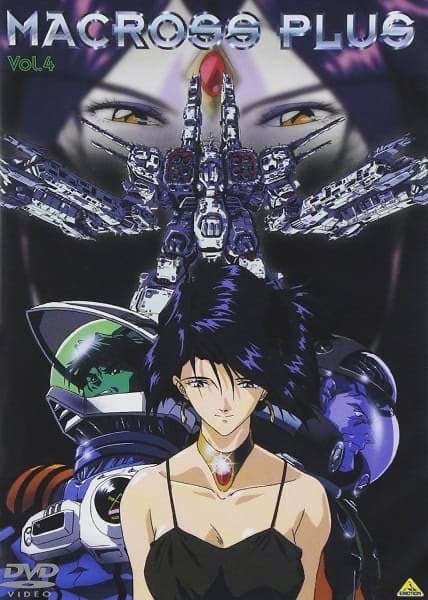
#anime#Macross plus#shinichiro watanabe#Keiko nobumoto#Yoko kanno#toshihiro kawamoto#Macross#cowboy bebop#90s anime#plutomango#mecha#mecha anime#Sharon apple#myeung#cowboybebop
76 notes
·
View notes
Text
Macross Zero Gets Me To Blog About Macross Here and It’s Honestly a Surprise How Little I've Done That Considering How Much I Like Macross as a Whole
12 Days of Aniblogging 2023, Day 7
What is Macross fundamentally about? Why is anyone drawn to this mecha franchise that’s played second fiddle to Gundam for nearly every step of its existence? The classic answer is the interplay between idols, mecha, and romance that Macross offers, with each iteration tweaking the balance to new results. But I think this viewpoint misses one of the most unique aspects of the original Super Dimension Fortress Macross anime, which is the culture war at the center of everything. The Zentradi are an alien race raised solely for battle, which gives them overwhelming firepower but leaves them deeply vulnerable to soft power. It's not the cool transforming ships that win the war, but romance and pop music and consumerist culture and pluralism and sickening amounts of gender. The Zentradi are literally humanized by the end of the show, as the nine-episode epilogue of SDF Macross is about the surviving humans and Zentradi trying to coexist in a new society built on the ruins of Earth, and the conflicts that arise from assimilation. For the most part it’s handled shockingly well for a 40-year-old show.

you bet your ass I'm just using macross baby throw instead of looking for a more relevant screenshot
Most of the later Macross installments downplay the contact narrative aspect, moving the continuity forwards and introducing new enemies that are either comically evil or uncaring hive-minds. And that’s fine! Instead, we get the insanity of Fire Bomber in Macross 7, and some of the best mechanical animation ever put to cel in Macross Plus. But as Macross Frontier and Delta go all-in on idols and sell ungodly amounts of CDs, eventually you start to feel like something’s missing.
Macross Zero is the one series I hadn’t gotten around to until this year. The only things I knew going in were that it was a relic of the early digital era, the first Macross to use CG for the dogfights, and focused primarily on native Pacific islanders. This all had me a bit worried! But what the setting actually entails is contact at the forefront of a Macross series again.
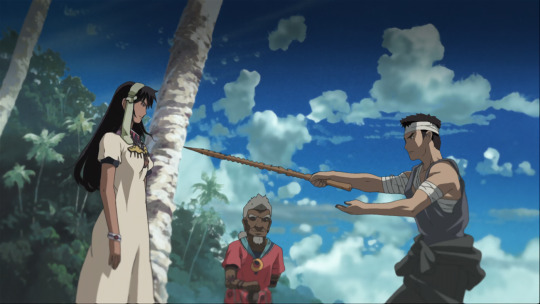
This is the first Macross chronologically, so it even though it has some alien tech that crash-landed to Earth, it predates actual alien contact and space war. Instead, all the major powers are wrapping up the Unification War, the “and then the Earth formed a world government to combat the imminent alien threat” narrative handwave of SDF Macross. We don't see much of the actual conflict on-screen, so instead it manifests as the settling of the frontier. The war is almost over and the fighting has been pushed to the fringes of the world, which means even nonaligned native islanders are at risk of being caught in the crossfire.
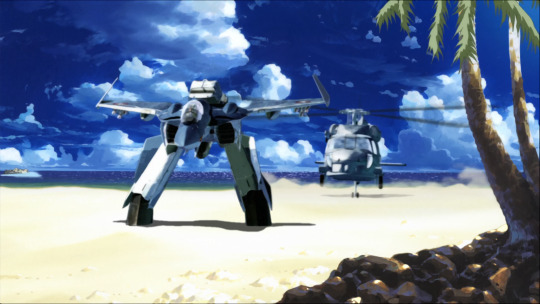
there's a real painterly nature to the backgrounds in this show, which helps the CG integrate quite well. Easily one of the best looking anime from the early 2000s.
Though the immediate problem is the military helicopters landing on the beach, it’s clear that the tribe has been facing the pressure of cultural imperialism for a long time now. Previous encounters have brought radios and generators to the island, and many members of the younger generations are leaving for mainland Asia to seek greater opportunities. This conflict manifests in the central love triangle as well. Sara Nome is a deeply religious traditionalist, while her younger sister Mao is the one interested in technology and anthropology. Macross Zero pulls no punches in depicting cultural isolationism as stifling and authoritarian. But the alternative is the end of their way of living, with only the potential for fragments of culture to persist through assimilation. And either way, the military being right at their door may soon render all this moot . The series grapples with hard problems in much better faith than most anime I've seen, which have a nasty tendency to advocate for colonialism.

Blood samples are one of Zero’s narrative through-lines, depicting the whole range of ethical hazards endemic to this kind of contact. The UN-sponsored cultural anthropologist who lands on the island takes indigenous blood samples under the half-truth that she’s going to test for diseases and treat the sick. Sara sees the writing on the wall, but can’t stop her from bribing the tribespeople with hard-to-get food and drinks. Of course, what the military scientists actually want to learn is how the islanders are linked to a suspected dormant protoculture superweapon, and to take advantage of it before the Anti-UN forces do the same.
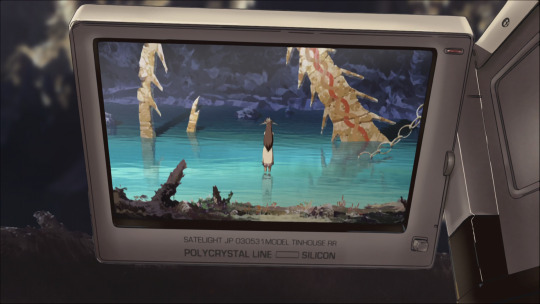
After discovering this, both the United Nations and the self-proclaimed anti-imperialist Anti-UN do not hesitate to use the island as a battlefield. While there’s plenty of sci-fi and magical macguffins during the last act, the show’s intentions remain firm. The can of worms opened when a UN fighter pilot first washed ashore reaches its inevitable conclusion, and everything burns and everyone has to be evacuated. Sara Nome reawakens the bird superweapon representative of her culture and ultimately uses it to open a portal, vanishing to parts unknown. That’s about the best this particular narrative can offer her viewpoint. Macross Frontier goes on to reveal that her sister Mao moved to the mainland and became a protoculture researcher, eventually becoming the grandmother of idol Sheryl Nome. It’s a fitting callback.

Zero is the most grounded and least optimistic Macross, and manages to avoid falling into pro-colonialist or noble savage viewpoints with its clear narrative focus. I would compare it to one of those UC Gundam side story OVAs, deliberately limited in scope but well-executed. One of the better ones.
Speaking of, Sunrise is going to be animating the next Macross anime! There’s a lot of possibilities, but first and foremost I hope they opt for a soft or hard reboot. Watching the most recent Delta movie left me to conclude that the internal chronology of the franchise has gotten far too messy, and it’s time to clean the slate so that culture shock can be brought to the forefront again. Of course, I’m also praying that they try to shamelessly cash in on G-Witch’s success by making The Gay Macross. God, what I would give for The Gay Macross. I could fill an entire second post with my ideas for The Gay Macross, but I’ll spare you for now.
14 notes
·
View notes
Text

I never really got to watch the original Super Dimension Fortress Macross. Here in the US we got ROBOTECH, which was fantastic, but it's not quite the same.
Macross Plus felt kind of standalone-ish? It didn't feel too tightly connected to the original storyline. There weren't returning characters or anything like that. So I just enjoyed that on its own terms...
But Macross 7 feels like a proper sequel/continuation of the story. We've actually got returning characters like Max and Miria. And it kept kind of nagging at me that I didn't know how the original story actually went. Especially because Exedol looked so very different from what I remembered.
Google tells me that Exedol's look in Macross 7 is based on his appearance in Macross: Do You Remember Love? - which I also hadn't watched.
So I decided to finally watch it... Which was easier said than done. Here in the US it's not trivial to actually watch the original Macross stuff. Pretty much everything is ROBOTECH even when you search for "Macross".
Eventually I found a decent copy on the Internet Archive.
And... It's confusing. I'm not sure this movie would even make sense if I wasn't already familiar with the Macross and ROBOTECH franchises.
I don't know if I should blame just the process of adapting a whole TV series down into a couple hours... Or if it's an issue with the translation/localization... But the story is barely ineligible. Everything happens so fast. Everything is mushed-together. Character motivations are vague and there's not really any time for development. Stuff just kind of happens. Max and Miria, for example, aren't even a side story. There's just maybe a minute of them on-screen.
So... Now I'm thinking I probably need to find the actual original Super Dimension Fortress Macross series and watch that...
1 note
·
View note
Text
Plastic Skies - Model 3: F-14A Tomcat
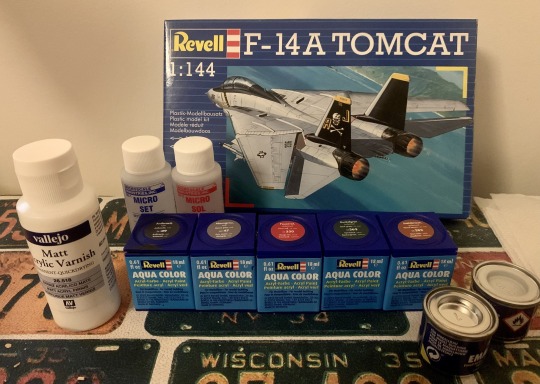
Last time, I’d run into my first proper obstacles and managed to come out on top but feeling like some changes had to be made. It was time to spread my wings a little in more than one way. I was feeling the need. The need for quality.
With my usual supplier still struggling to get some of the stuff I needed, namely decal solution, I decided to start looking elsewhere. Buying supplies online was fine but I preferred checking out actual shops, not just for the items but for the chance to talk with experienced people and get some tips on how to use all these new tools. Eventually I settled on a couple of places inside two shopping galleries, which turned out to be an incredibly amusing dichotomy: one shop had every possible tool I needed but a relatively small amount of models, while the other had barely any tools but like six different displays and three walls absolutely brimming with kits.
I went to that second one first. Due to some miscommunication and a little embarrasment, I walked out with two cans of enamel paint that I don’t really use because I’m more of an acryllics guy (so far). But more importantly, I also got a small 1:144 Revell Tomcat. A price hike from my last ones, but not a particularly steep one. And I figured, if I wanted quality kits, Revell was the way to go. As for the model, well... it’s a Tomcat. You show me someone who doesn’t like the Tomcat and I’ll show you the miraculous man without a heart.
The second shop yielded a much better bounty. There, I finally got my decal solutions, plus a bottle of varnish (which I’d seen on tutorials was the final step to a good decalling) and a box of red paint that I wasn’t gonna use for the Tomcat but figured I’d have around for possible future projects. This would eventually represent another small turning point in this whole new hobby, but more on that later. For now, I had work to do.
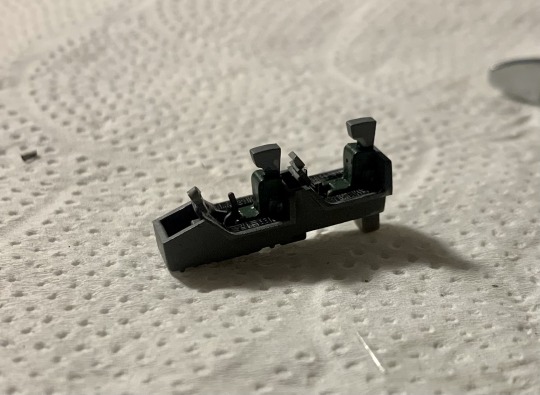
Right out of the box, I could tell these German motherfuckers were not fucking around. My last two models’ instructions had been a single sheet of photocopied paper. This one had a whole 12 page booklet, plus a second health warning booklet, plus a decal sheet twice as big as the last two combined. This was the proverbial Something Else. And if there was any doubt in my mind, that changed quickly the moment I looked at the instructions and started building the cockpit. The damn thing has decals for the control panels, despite the fact that you can’t see them even with a magnifying glass in the final build. And then there were the wings.
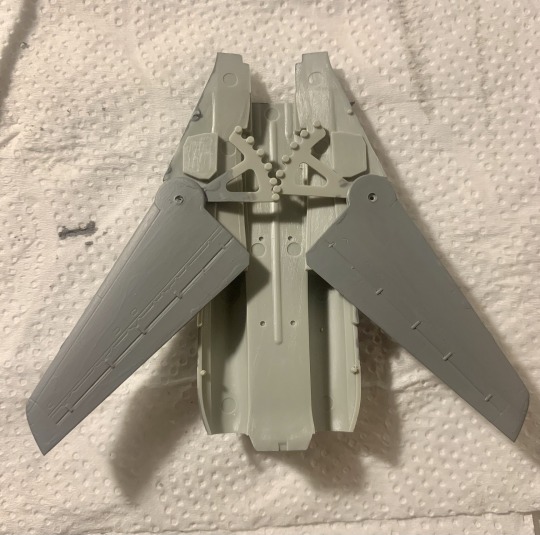
I’d seen them in the instructions booklet so I understood the general idea, but I still found myself smiling like a baby once I put them in. Such a simple and elegant solution that brought this closer to a toy than a model. If I didn’t love it yet, I was ready to buy this model dinner and a drink now.
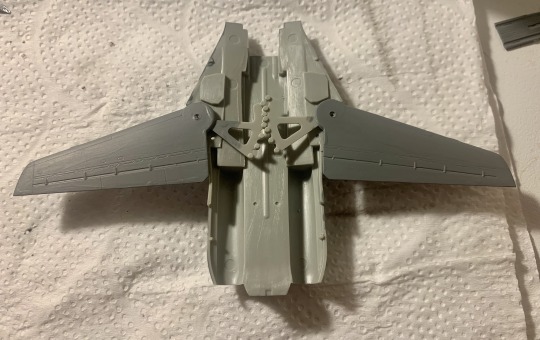
Funny enough, while my brother and I never built a Tomcat as kids (we didn’t see Top Gun until we were both in our teens, so our only real attachment to the plane for years was just Afterburner and Macross’ Valkyries), I do remember owning a pretty well-made toy plane, with the swing-wings and all, that I proudly displayed next to all the other models. It was at least three times bigger than the one I was building now, but as I pushed those little wings back and forth, I could feel its spirit coming back to me.

The rest of the construction went mostly well. Lots of silent admiration for the hyper detailed panel lines and little details, most of which managed to survive even my clumsy brush strokes (and the darker-than-recommended shade of gray I used). Things only really started to get annoying once I tried to decal the plane’s six missiles. A combination of inexperience with decal solution and abject terror for the safety of the decals themselves (which turned out to be mostly unfounded because Revell decals are sturdy motherfuckers) meant that the process was slow and excruciating, and the results rather shoddy.

Likewise, the landing gears were a small big nightmare. Revell and a few other companies really like making these small parts that you can then slice into two or three or four even smaller parts to complete, for example, the landing gear doors. Which is theoretically great because it offers more of that sweet sweet customization, but in practice is a recipe for a horrorshow. You can see its results on the monstrously mangled doors of the frontal gear of this pure plane, and while harder to notice, there were two pieces of the back gears that I straight-up didn’t even try to glue in. I value my sanity more than the presence of a half-inch piece of plastic.
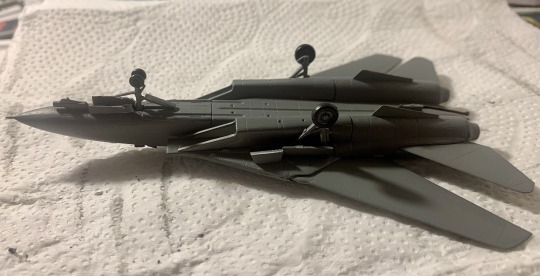
Slowly, painfully, I managed to complete the main build and reach the final stage: the full decalling. To my amusement, the instructions included two options. One was an actual real life Tomcat from the USS Nimitz, pilot names and all. The other turned out to be a Tomcat from a movie I’d never heard before, THE FINAL COUNTDOWN, about the aforementioned USS Nimitz travelling in time back to Pearl Harbor in 1941 and... I actually haven’t seen the movie yet and reviews say it’s kinda meh, but it’s absolutely on my Lazy Sunday list.
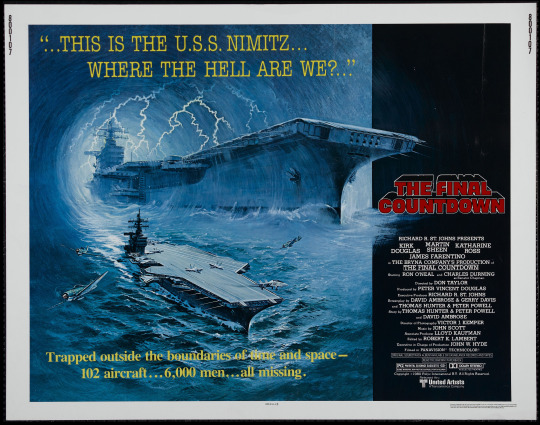
However, I settled for the real life decal sheet, mostly because the other one had a couple of extra decals and I wasn’t feeling like doing even more work. I was already quite frustrated by the missiles and landing gear, and decaling the tailfins/canopy didn’t help. Decal solution was certainly making things easier, but not exactly easy enough. Silvering was becoming very noticeable. And those damn wrap-around yellow tops kicked my ass pretty hard. But at least I got the Jolly Rogers on... somewhat.
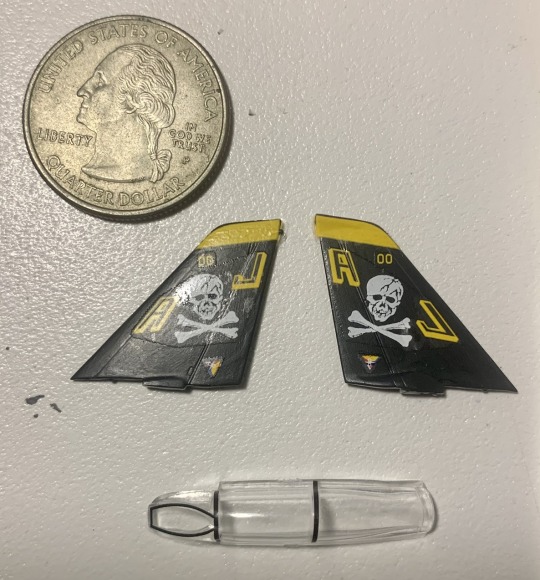
I finished those late at night on a Friday, then went to sleep dreading what was going to come next. The tiny names, the sneaky corners, the endless work that would surely stretch for hours and hours. It was going to be a pain in the ass. But when I actually got down to it the next morning, something... clicked. Something happened. Maybe I just needed the rest or the extra daylight, but decaling the sides of the plane wasn’t a pain at all. In fact, it ended up being downright fun. And more importantly, tremendously satisfying.

Each new decal that I placed just peeled away at the layer of fear that used to cover them. Even the really small ones, the ones that went in some tiny corner of the plane right behind the missiles I’d already glued on, ended up being a ball to just softly slide around with a toothpick. Maybe it just spoke to my inner desire for visual order. I’m 100% the kind of person that straightens picture frames and orders his shelves by publisher. So moving these strong decals around until they were at the perfect position was deeply soothing to me. Even the tiny red stripes gave me almost no trouble. And before I knew it, I was putting in the final coats of varnish. It was done.

Of course, a new finished model meant another round of pictures to show to family members and friends, who I’m sure by now were beginning to get a little tired of my constant droning. Still, as previously established, nobody with a heart can resist the allure of a nice Tomcat. And now I had far more angles to show off.
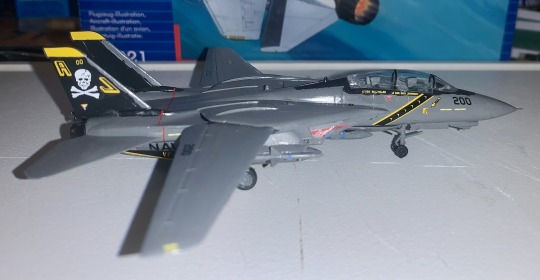
And then there was that turning point I mentioned. Because while I was varnishing the F-14, I realized the varnish, the decal solution, these new things I had... well, no reason why I couldn’t use them on the two older models. No reason why I couldn’t give the Mirage’s decals some solution to try and get the silvering out, or why I couldn’t try to polish that poor misshappen MiG-21 with some varnish. Which was exactly what I did before the Tomcat had even finished drying.
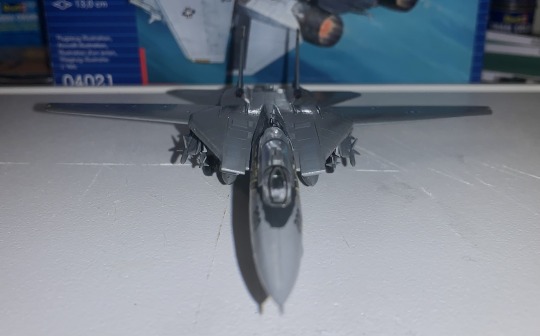
Like doing the decals, it was another moment of great satisfaction to use the tools I’d tried out and the experience I’d accumulated to make those previous kits shine a bit more. To know that a lot of the things I learned could be applied not just to the current model but to all of them. It was a notion that made me want to try even more new things, even the really intimidating ones. I found myself locked into the best kind of feedback loop that any hobby has to offer, where you can see yourself improve in real time while also receiving physical, empirical evidence of that improvement. I was getting better. I was getting braver.
And on the next model, I told myself, I was really going to test myself.
#My Stuff#Hobbies#Journals#And yes#That Tomcat's pilot really was called#Lt Col Dick Johnson#I'm sure he was extremely popular with the crew#Or at least#Nice to have at a party
9 notes
·
View notes
Text
Fate and Phantasms #175

Today on Fate and Phantasms we’re entering the Dead Heat Summer Race! That’s right, we’re finally doing some Summer servants... in the Summer! We’re still a year off, but at least they’ve got the spirit!
As an added challenge, I’ll make sure all the teams get their own car! Fran & Maid Alter get a pass since they’re teamed up with people that already have cars (Babbage & Nero, respectively), but the others will all have their own vehicles to ride!
Anyways, today we’re building Nero Claudius... again. I promise this is... probably(?) the last time. She’s a Creation Bard to build up her golden theater on the sea as well as a sick car. She’s also a Draconic Soul Sorcerer to grab those giant guns she’s got on her back.
Check out her build breakdown below the cut, or her character sheet over here!
Next up: Team Electric Steam feat. Papa!
Race and Background
Nero is still a Human Noble. This gives her +1 to any two stats, and her Constitution and Charisma will need rounding up in a second, so go with those. She also gets proficiency with History, Persuasion, and Performance, plus the Lucky feat to re-roll her attacks, saves, and checks plus incoming attacks three times per long rest. You might be in a bikini, but you’re still the emperor. You get what you want, and what you want is just about everything.
Ability Scores
Surprising no one, your Charisma is your highest stat. The race was basically a popularity contest, and you won almost every leg of it. Second is Dexterity- you’re fighting in either a dress or a swimsuit, but in either case it’s definitely not armor. Your Constitution is next, races take a while and there’s no time to stop for snacks, so you’ll have to toughen up a bit. After that is Intelligence. You’re flighty, not dumb. Your Strength isn’t amazing, you don’t really need big muscles to look good, but we’re dumping Wisdom. It wouldn’t be high at the best of times, and the caster class suits you to a dangerous degree.
Class Levels
1. Sorcerer 1: Starting off as a sorcerer may get you less health and fewer proficiencies, but you still get Constitution and Charisma saves, as well as Arcana and Religion. You’re a caster now, it’s time to act like one.
The big reason we’re starting here right away is for the goody you get from being a Draconic Bloodline sorcerer, Draconic Resilience. Thanks to your great-great-great-great-great-grandparent Dragon Ancestor being a red dragon, you get an extra 1 hp for each level of this class, as well as a doubled proficiency bonus on charisma checks involving dragons.
You also get an unarmored defense of 13 + your dexterity modifier. Now you can wear a swimsuit anywhere you like without issues. I’d still recommend you don’t meet the king dressed like that, but you’re a noble, I’m sure he’s already expecting a bit of eccentricity.
You can also cast Spells using your Charisma, grab Light and Minor Illusion to put on a good show, Sword Burst so you can actually use a sword (we’ll get better options later), and Magic Missile and Create Bonfire for some quick shots from your cannons. You also get Absorb Elements, because this and Blade Ward are the easiest to get “weakness nullifying” spells, and this one’s actually good.
2. Bard 1: Bouncing over to bard real quick gives you another set of Spells that also use Charisma. You also get Bardic Inspiration, d6s you can hand out as a bonus action to allies. While they have one, they can add it to an attack, save, or check they have to make. You have Charisma Modifier inspiration dice to give out per long rest.
You do whatever you want, and while Prestidigitation isn’t quite that open-ended, it’s still pretty good for a single spell. You also get Friends, Command and Charm Person to be your usual charming self. Grab Cure Wounds for just a touch of healing, and Feather Fall. You’ve got giant metal wings, they should be good for something, right?
You get proficiency with Animal Handling as well.
3. Bard 2: Second level bards are Jacks of All Trades, adding half their proficiency bonus to all ability checks. You can also perform a Song of Rest on short rests, adding 1d6 to healing done. Your dulcet tones inspire everyone around you! (Usually to put as much distance between themselves and you as possible, but hush)
Your inspiration also turns into Magical Inspiration- creatures can use your inspiration to add to their spell’s damage or healing potential.
Finally, you get the spell Unearthly Chorus, which doesn’t have any damage or healing potential! It just makes you even better at charisma checks. It’s also very flavorful for someone about to open a theater.
4. Bard 3: Third level bards graduate from their college, and the College of Creation will one day allow you to afford a car! For now, you only have a Note of Potential, adding extra effects to your inspiration depending on how they’re used. Adding one to an ability check gives the user advantage on the die roll. Adding it to an attack roll deals thunder damage to the target and each creature next to it that fails a constitution save. Adding it to a saving throw adds temporary hp to the user equal to the roll plus your charisma modifier.
You know how I just said you only have the note? We lied. You can also make a Performance of Creation once per long rest or by spending a second level spell slot. You can create any nonmagical item, as long as it is worth less than 20 times your bard level in GP, and medium or smaller. Neither of those restrictions will help you make a car, but they’ll improve as you level up.
Finally, you get Expertise in Animal Handling and Arcana, doubling your proficiency bonus in both skills.
For your spell, Enhance Ability makes it easier to do whatever you set your mind to, giving advantage on one kind of ability check for the duration.
5. Bard 4: Use your first Ability Score Improvement to bump up your Charisma for stronger spells and more inspiration.
You also learn the Dancing Lights cantrip so you can put on even better shows, and Pyrotechnics for pretty much the same reason. You need an existing source of fire to set it off, but you can always combo it with Create Bonfire in a pinch.
6. Bard 5: Fifth level bards are a Font of Inspiration, recharging your inspiration on short rests instead of long ones. Also, your inspiration grows to d8s.
You can also make a Motivational Speech with a third level spell slot, giving your party temporary HP, advantage on wisdom saves, and advantage on its next attack if it gets hit by an attack.
7. Bard 6: Countercharm is okay, spend an action to give advantage to your party on charm and frightening saves, but we’re really here for your subclass specialties. Your Performance of Creation can make Large objects now, and you can spend an action to make an Animating Performance, turning a large or smaller (gee, that worked out nicely) object into a Dancing Item for up to an hour. It’ll only dodge on its turn unless you use your bonus action to command the thing, but you can inspire people and command it in the same action. You can make a dancing item once per long rest, or by using third level spell slots. Also, you can only have one at a time. I’m pretty sure a functional car in a medieval setting is worth more than 120 gold though, so we’ll work on it some more later.
For your spell, I’d suggest Suggestion, it’s very useful for making the world revolve around you.
8. Sorcerer 2: Second level sorcerers become a Font of Magic (you are just becoming a font for all sorts of crap, huh?), giving you sorcery points equal to your sorcerer level. You can turn spell slots into points, or points into slots, or even cooler stuff next level!
For now, the big new thing is you can cast Shield. Those giant metal wings make it harder to hit you than you’d think.
9. Sorcerer 3: Third level sorcerers get that cooler thing I was just talking about, Metamagic! When you get it now, you get two metamagic options that can alter how your spells work; Heightened spells force disadvantage against their save on one creature they effect, and Twinned spells target two creatures instead of only one (Note: twinned spells only work on spells that target a single creature.)
You also get Scorching Ray, giving you a macross missile massacre of fire out of those organcannons you’re hauling around with you.
10. Bard 7: We’re stopping back in bard real quick to grab your fourth level spell, Hallucinatory Terrain. Somehow you always bring the waterfront with you when you use your NP, and now you really can do that!
11. Sorcerer 4: Use this ASI to max out your Charisma for the best spells possible. Speaking of the best spells possible, you can cast True Strike now for advantage on an attack next turn! You can also cast Shadow Blade so you have a sword you can attack with. A cool, spooky sword that deals psychic damage and has advantage against targets in the dark. Yes, it took us half the build to get a sword, that’s what happens when you’re a cavalry class.
12. Sorcerer 5: Fifth level sorcerers are even better at skill checks now thanks to their Magical Guidance, using your sorcery points to reroll failed checks for, essentially, permanent advantage on whatever you do.
You can also cast Water Walk. Eventually your NP will involve actual water, so you’ll want to be prepared for that. Forcing your whole party to do the doggy paddle every time you want to cut loose isn’t a great look, be a team player here.
13. Sorcerer 6: Our last stop on the sorcerer train is sixth level, giving you an Elemental Affinity for fire. All your fire damage spells get your charisma added to their damage, and you can spend a sorcery point after casting one of them to gain resistance to fire damage for an hour. Always remember to apply sunscreen throughout the day. Now more than ever, that shit gets hot.
To take advantage of this new affinity, you can cast Melf’s Minute Meteors, launching chunks of those cannons off and firing a couple per turn at your enemies, dealing fire damage in a small area around their destination. Creatures have to make a dexterity save, and if they succeed they take half damage. Like scorching ray, these are multiple instances of fire damage, so add your charisma to each one.
14. Bard 8: Back in bard for good now! Use this ASI to bump up your Dexterity so you can start being good with a sword. Just in case that’s still not enough, you can cast Charm Monster now too. You have enough gravitas to bend the authors to your will, I’m sure you can handle a manticore or two.
15. Bard 9: Your Song of Rest grows to 1d8 now, but more importantly you get fifth level spells! Animate Objects is another way to build your car (we’re still 5 levels away from performance of creation building it) or to get your cannon bits into position.
16. Bard 10: Tenth level bards get another cantrip! Honestly, we probably should’ve gotten Mending earlier. Adventuring in an outfit where a single snapped string can completely remove your top isn’t a great idea. You also get Magical Secrets, giving you two spells from any spell list. Flame Blade gives you a more thematically appropriate weapon, and Fireball is a big boom you can fire off.
On top of that, you get another round of Expertise, doubling your proficiency in Performance and Persuasion.
You also get a bigger inspiration, letting you hand out d10s.
17. Bard 11: Eleventh level bards get sixth level spells, like Mass Suggestion. It’s like Suggestion, but for the masses.
18. Bard 12: Use this last ASI to bump up your Dexterity again for a higher AC and better swordplay.
19. Bard 13: Your song of rest increases to a d10 as well, and you get the seventh level spell of champions, Mirage Arcane! If you make an illusion you can really feel, is it still an illusion? Anyways, you can make your golden theater now and the ocean surrounding it, and it all lasts for 10 days!
20. Bard 14: Your capstone level of bard lets you hit a Creative Crescendo, creating up to five items at once when you use your Performance of Creation. One of those objects can be Huge, the rest all have to be Small or smaller. You also don’t have to worry about cost when making objects, so that car is finally within reach!
You also get Magical Secrets again for two more spells. Prismatic Spray gives your golden theater some big ass cannons, creating a 60′ cone of light that deals different kinds of damage and effects. You also get Tenser’s Transformation, turning you from a full caster class into a proper fighter once more. You get temporary HP, permanent advantage on weapon attacks, you deal extra force damage, gain proficiency with all weapons as well as strength and constitution saves, and you can attack twice per action. The downsides are you can’t cast spells and after it ends you have to make a constitution save afterwards to prevent exhaustion, but I think it’s appropriate that we finally gave Nero those migraines she’s always complaining about.
Pros:
As usual, nero’s build is pretty adaptable, with a little bit of everything to help out any dedicated role in the party. She has healing, dps spells, utility, social graces, pretty much all skill checks, and also literally the ability to make whatever item she might need in a given situation.
Tenser’s Transformation is meant to turn wizards into melee fighters, and you’re (more or less) a bard. With almost 200 HP thanks to this spell and the ability to make your own armory, you can turn yourself into a terrifying war god practically at will.
Elemental Affinity can be really scary if you game the system right. Max out a casting of scorching ray to deal 20d6+50 damage to a single target. That’s better than a 9th level fireball. It also gives resistance to one of the most common damage types!
Cons:
Fire is one of the most common damage types, so it’s also one of the most common resistances. You have other stuff to fall back on, but it’ll put a crimp in your style if you go up against fire elementals. Or water elementals. Or fiends. Or- you get the picture.
We don’t improve on physical stats until level 14, which means you’ll be stuck with an AC of 15 for a majority of the game, and your sword skills won’t be that useful until very late in the campaign.
The big moment where the build really comes together as Nero is around level 19-20, meaning most players will never actually reach that point. Sorry guys, Nero is a luxury few can afford.
26 notes
·
View notes